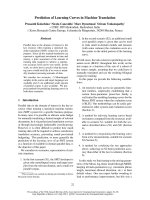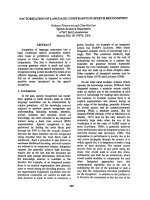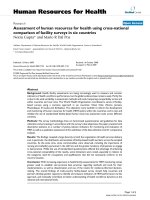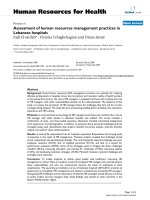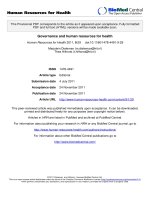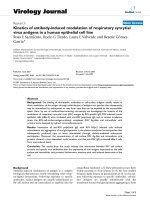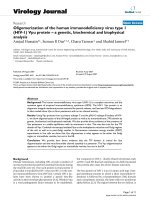báo cáo sinh học:" Assessment of human resources for health using cross-national comparison of facility surveys in six countries" ppt
Bạn đang xem bản rút gọn của tài liệu. Xem và tải ngay bản đầy đủ của tài liệu tại đây (420.91 KB, 9 trang )
BioMed Central
Page 1 of 9
(page number not for citation purposes)
Human Resources for Health
Open Access
Research
Assessment of human resources for health using cross-national
comparison of facility surveys in six countries
Neeru Gupta* and Mario R Dal Poz
Address: Department of Human Resources for Health, World Health Organization, Geneva, Switzerland
Email: Neeru Gupta* - ; Mario R Dal Poz -
* Corresponding author
Abstract
Background: Health facility assessments are being increasingly used to measure and monitor
indicators of health workforce performance, but the global evidence base remains weak. Partly this
is due to the wide variability in assessment methods and tools, hampering comparability across and
within countries and over time. The World Health Organization coordinated a series of facility-
based surveys using a common approach in six countries: Chad, Côte d'Ivoire, Jamaica,
Mozambique, Sri Lanka and Zimbabwe. The objectives were twofold: to inform the development
and monitoring of human resources for health (HRH) policy within the countries; and to test and
validate the use of standardized facility-based human resources assessment tools across different
contexts.
Methods: The survey methodology drew on harmonized questionnaires and guidelines for data
collection and processing. In accordance with the survey's dual objectives, this paper presents both
descriptive statistics on a number of policy-relevant indicators for monitoring and evaluation of
HRH as well as a qualitative assessment of the usefulness of the data collection tool for comparative
analyses.
Results: The findings revealed a large diversity in both the organization of health services delivery
and, in particular, the distribution and activities of facility-based health workers across the sampled
countries. At the same time, some commonalities were observed, including the importance of
nursing and midwifery personnel in the skill mix and the greater tendency of physicians to engage
in dual practice. While the use of standardized questionnaires offered the advantage of enhancing
cross-national comparability of the results, some limitations were noted, especially in relation to
the categories used for occupations and qualifications that did not necessarily conform to the
country situation.
Conclusion: With increasing experience in health facility assessments for HRH monitoring comes
greater need to establish and promote best practices regarding methods and tools for their
implementation, as well as dissemination and use of the results for evidence-informed decision-
making. The overall findings of multi-country facility-based survey should help countries and
partners develop greater capacity to identify and measure indicators of HRH performance via this
approach, and eventually contribute to better understanding of health workforce dynamics at the
national and international levels.
Published: 12 March 2009
Human Resources for Health 2009, 7:22 doi:10.1186/1478-4491-7-22
Received: 16 October 2008
Accepted: 12 March 2009
This article is available from: />© 2009 Gupta and Dal Poz; licensee BioMed Central Ltd.
This is an Open Access article distributed under the terms of the Creative Commons Attribution License ( />),
which permits unrestricted use, distribution, and reproduction in any medium, provided the original work is properly cited.
Human Resources for Health 2009, 7:22 />Page 2 of 9
(page number not for citation purposes)
Background
Human resources are a strategic capital in any organiza-
tion, but particularly so in health and other service organ-
izations that are highly dependent on their workforce. The
functioning and growth of health systems depends on the
availability of human resources and on the time, effort
and skill mix provided by the workforce in the execution
of its tasks [1,2]. There is growing international recogni-
tion that one of the key ingredients in achieving improved
population health outcomes is an adequate and available
health workforce [3,4]. At the same time, there is general
consensus that human resources for health (HRH) have
been a neglected component of health systems develop-
ment in low-income and middle-income countries [5].
Many countries lack the human resources needed to
deliver essential health interventions for a number of rea-
sons, including limited production capacity, migration of
health workers within and across countries, poor mix of
skills and demographic imbalances. The formulation of
national policies and plans in pursuit of health workforce
development objectives requires sound information and
evidence. Against the backdrop of increasing demand for
information, building knowledge and understanding of
the health workforce requires coordination across sectors.
It is being increasingly recognized that cross-national
comparisons provide opportunities for gaining insights
into many HRH issues of major concern to many coun-
tries and learning how other countries have dealt success-
fully or otherwise with these issues [6].
Although a number of sources exist even in low-income
countries that can potentially provide data relevant to
health workforce analysis – including population- and
facility-based censuses and surveys, as well as administra-
tive and management records – information on health
system personnel is often fragmented or incomplete.
Health facility assessments are being increasingly used to
measure and monitor indicators of health worker per-
formance, but the global evidence base remains weak [7].
The diversity of methods and tools used to implement
data collection means that considerable variability occurs
in data coverage and quality, hampering comparability
across and within countries and over time. For example, a
previous analysis of health worker distribution using facil-
ity data from three developing countries acknowledged
that the lack of a standardized occupational coding sys-
tem to identify provider type resulted in difficulties in
conducting cross-national comparisons [8].
To strengthen the evidence base on HRH from an interna-
tional perspective, the World Health Organization
(WHO) coordinated a series of facility-based assessments
in six low-income and middle-income countries. The
objectives were twofold: to inform the development of
HRH policy within the countries and to test and validate
the use of standardized survey instruments across differ-
ent contexts. Four of the countries were located in Africa
(Chad, Côte d'Ivoire, Mozambique and Zimbabwe), one
in Asia (Sri Lanka), and one in the region of Latin America
and the Caribbean (Jamaica). As seen in Table 1, the coun-
tries present a large diversity in basic demographic and
health indicators, notably in terms of population size
(from under 3 million in Jamaica to nearly 20 million in
Mozambique), life expectancy (from 37 years in Zimba-
bwe to over 70 in Jamaica), and infant mortality (from
under 20 deaths per thousand in Jamaica and Sri Lanka to
124 in Chad). The four African countries have been iden-
tified as having a critical shortage of skilled medical, nurs-
ing and midwifery personnel [9].
This paper presents the main findings of the six survey-
based HRH assessments. In accordance with the assess-
ment's overall objectives, the analysis here follows a two-
pronged approach: in terms of the usefulness of the data
collection tool for cross-country comparisons, and in
terms of country-specific findings relevant for HRH policy
and planning.
Methods
The Assessment of Human Resources for Health was con-
ducted in six countries between 2002 and 2004, with tech-
nical and financial support from WHO. A common
approach was proposed to collect data by means of per-
Table 1: Selected demographic and health indicators by country (around 2004)
Income category* Population (millions) Life expectancy at birth (years) Infant mortality rate** (‰)
Chad Low 9.7 44.0 124
Côte d'Ivoire Low 18.2 46.2 118
Jamaica Lower-middle 2.7 70.9 17
Mozambique Low 19.8 41.8 100
Sri Lanka Lower-middle 19.6 74.7 12
Zimbabwe Low 13.0 37.3 81
Sources: UNESCO Institute of Statistics Data Centre; World Bank World Development Indicators database, April 2007.
* Income category as classified by the World Bank according to 2006 Gross National Income (GNI) per capita.
** Infant mortality rate = Number of newborns dying under a year of age per thousand live births.
Human Resources for Health 2009, 7:22 />Page 3 of 9
(page number not for citation purposes)
sonal interview with a sample of facility-based health care
providers on a number of topics, including professional
qualifications, demographic characteristics, work activi-
ties, workplace conditions and remuneration [10]. An
additional questionnaire at the level of the facility was
designed to collect supplementary information on staff-
ing distribution by location and other characteristics of
place of work, and a third questionnaire was used to com-
pile national-level information from health ministries
and professional councils on regulation of health occupa-
tions.
The methodology drew on standardized questionnaires
and guidelines for data collection and processing. In order
for the eventual results to be comparable across countries,
it was recommended that the sampling frames be com-
piled the same way in every setting, and that the question-
naires be filled the same way with each respondent. As
such, standard training guidelines were provided by WHO
for all field enumerators. Standard data entry software
templates were also developed for all data entry operators,
by means of the SPSS Data Entry Builder software pro-
gram [11]. The instruments were translated to meet the
language needs of some countries, but otherwise essen-
tially unchanged. In particular, a pre-coded list of (pre-
sumed) occupational titles for facility staff was provided
drawn from the International Standard Classification of
Occupations (ISCO), a framework for enhancing compa-
rability of labour statistics by means of grouping of jobs
according to shared characteristics [12].
Data collection and processing were implemented in each
country by a national collaborating agency: Centre de
Support en Santé Internationale/Institut Tropical Suisse
au Tchad (Chad), Ministère de la Santé (Côte d'Ivoire),
Ministry of Health (Jamaica), Ministério da Saúde/Centro
Regional de Desenvolvimento Regional Sanitário
(Mozambique), Ministry of Health (Sri Lanka), and the
University of Zimbabwe (Zimbabwe).
This analysis focuses on key results from the health care
providers questionnaire (see Additional File 1). We
present descriptive statistics on a number of policy-rele-
vant indicators for monitoring and evaluation of HRH,
including skill mix, age and sex distribution, educational
attainment, institutional sector and labour market activity
[13]. Where appropriate, additional quantitative and
qualitative information compiled via the questionnaires
on health facilities and regulation of health occupations
as well as field reports from the national implementing
agencies are used for country-specific contextual analysis.
The sample size of providers surveyed in each country is
presented in Table 2. The final number of respondents
ranged from 364 in Jamaica to 2354 in Sri Lanka. Based
on the original guidelines, it was expected that the sample
would be drawn using a stratified systematic random
selection technique to include representation across each
country's main regions, the different types of facilities
(hospitals/health centres, public/private) and the various
workforce domains (occupation, age group, sex, etc.).
(It may be noted that general information from a range of
countries using different tools for assessment of facility-
based service delivery points, including HRH, as well as
news on international technical cooperation efforts and
developments in strengthening facility-based data collec-
tion and use, is available on the web site of the Interna-
tional Health Facility Assessment Network [14].)
Results
Implementation of data collection
Despite efforts to reduce survey variances across countries
by means of standardized data collection tools and
approaches, considerable variations did occur in imple-
mentation due to specificities of national health systems
as well as logistic, technical and sociopolitical reasons.
First, it must be recognized that in most countries the final
survey samples was biased towards the public sector. In
many countries the response rate of facilities and provid-
ers in the private sector was low. In Mozambique, for
instance, although 45 private clinics had initially been
identified and included in the sampling frame, the
response rate was very low, and this despite repeated con-
tacts from the field investigators, to the extent that the
eventual results presented here have been limited to pub-
lic sector providers alone (Figure 1). Among the main rea-
Table 2: Sample size of health facilities and providers, Assessment of Human Resources for Health, 2002–2004
Number of sampled facilities Number of surveyed health care
providers
Mean number of providers surveyed per
facility
Chad 213 545 2.6
Côte d'Ivoire 313 709 2.3
Jamaica 214 364 1.7
Mozambique 195 737 3.8
Sri Lanka 222 3130 14.1
Zimbabwe 105 1026 9.8
Human Resources for Health 2009, 7:22 />Page 4 of 9
(page number not for citation purposes)
sons cited for non-response to the survey were
misconceptions about the purpose of the assessment (i.e.
government inspection rather than research and policy
purposes alone) and work overload. In Jamaica, only 5%
of private physicians were surveyed. On the other hand, in
Sri Lanka, a representative of the Independent Medical
Practitioners Association was involved in the survey group
from the initial planning stages. Data collection was more
successful in the private sector in this context. The highest
proportion of private providers interviewed was found in
Côte d'Ivoire, where civil conflict and worsening socioe-
conomic conditions between 2002 and 2004 have been
linked to exacerbated worker shortages and high levels of
attrition in the public health sector [15].
A shortage of health personnel, and particularly certain
highly skilled cadres, was a hindrance in some countries
to meeting the original sampling design. In Mozambique,
the sample of facilities was changed during the course of
fieldwork in some areas because of an unanticipated lack
of personnel available for interview. In Jamaica, a number
of the smallest (Type 1) government-operated primary
health centres were found to be closed on the day of the
visit, so some types of other, larger health centres (Types
2–5) were oversampled instead. In Sri Lanka, the mini-
mum number of providers to be interviewed per facility
was increased to capture more workers in smaller facili-
ties.
Limited information and communications technologies
in some countries affected the survey implementation
processes. In Jamaica, it was not possible to compile a
master list of all currently employed health workers in
government and private health facilities because much
depended on the level of computerization of local man-
agement information systems. (The required information
was eventually obtained during the course of fieldwork
from the individual facilities or providers themselves.) A
lack of email service at the Ministry of Health's Depart-
ment of Human Resources in Côte d'Ivoire resulted in
some delays in coordinating efforts and sharing knowl-
edge. This situation was reflective of a widespread lack of
information technology and telecommunications across
the African region: a 2004 study conducted by the WHO
Regional Office for Africa showed that 22% of health
workforce departments in ministries of health in the
region did not have computer facilities, 45% had no email
access and 68% did not have a fax machine [16].
As previously mentioned, Côte d'Ivoire experienced civil
conflict around the time of the survey. Fieldwork was
delayed by several months from the original plans due to
the sociopolitical crisis, and when eventually imple-
mented the sampling was subject to significant modifica-
tions compared with the initial design. Some parts of the
country were not covered, and the final sample of 313
facilities represented only 73% of the initial target – with
relatively more private than public facilities captured,
compared with the original plans (75% versus 68%). In
Sri Lanka, some parts in the north and east of the country
were excluded from the sampling frame due to long-
standing civil conflict in those areas.
Profile of the health workforce
Globally, the health workforce is characterized by a diver-
sity of occupations and skills. However the specific mix
varies greatly across contexts. While there is no interna-
tional "gold standard" for an appropriate skill mix to meet
the health needs of a given population, measuring this
mix offers a means to assess the combination of categories
of personnel at a specific time and identify possible imbal-
ances related to a disparity in the numbers of various
health occupations.
In all the six countries, nursing and midwifery personnel
represented the largest group of facility-based workers sur-
veyed (Table 3). In Jamaica, community health aides were
also captured in this group, considered to be equivalent to
auxiliary nurses. The share of physicians ranged from a
high of 26% in Sri Lanka to some 5% to 7% in Chad,
Mozambique and Zimbabwe. Few pharmacists or physio-
therapists were found in any of the survey samples. The
catch-all "other" category captured a very large share of
workers in some countries, including a wide range of mid-
dle- and lower-level service providers (such as medical
assistants, dental assistants, pharmaceutical auxiliaries
and X-ray technologists) as well as health management
and support staff (such as administrators and mainte-
nance crews) needed to keep facilities running.
Percentage of surveyed health care providers working in gov-ernment-operated facilitiesFigure 1
Percentage of surveyed health care providers work-
ing in government-operated facilities.
Human Resources for Health 2009, 7:22 />Page 5 of 9
(page number not for citation purposes)
As expected, along with wide differences in the workforce
skill mix, variations were also observed in the level of pro-
fessional education and training among surveyed health
workers, both within and across countries. In Zimbabwe,
while all physicians reported having a university educa-
tion, only a quarter of nursing and midwifery personnel
did so (Figure 2). In Jamaica, all the respondents reported
having university or professional qualifications that ena-
bled them to practise legally in the country, while in Chad
only 15% of respondents had a university diploma in
health care (results not shown). In Sri Lanka, national reg-
ulations require all health service providers except auxil-
iary nurses and midwives to receive their training at
government-operated education institutions. In Mozam-
bique, 42% of physicians reported having conducted their
studies in another country.
In Jamaica, Sri Lanka and Zimbabwe, women comprised
at least 70% of the health workforce (Figure 3), making
them indispensable as contributors to the delivery of
health care services in these countries. In contrast, in Chad
only 19% of surveyed health workers were women. In all
the countries, women tended to be concentrated among
nursing and midwifery personnel and mostly lower-level
occupations, and were poorly represented among physi-
cians. In Côte d'Ivoire and Mozambique a majority of
nursing personnel were male, but midwifery personnel
were predominantly women (results not shown).
The age distribution of the health workforce can be an
indicator of renewal of personnel. According to the survey
findings, Zimbabwe had the youngest facility-based work-
force, with one quarter of health workers and half of phy-
sicians aged under 30 years (Figure 4). In contrast, in
Chad none of the interviewed physicians was under 30.
Although the sample size was small, with only 28 physi-
cians included in the Chad survey, the results do suggest
Table 3: Percentage distribution of the facility-based health workforce by occupation, Assessment of Human Resources for Health
Chad Côte d'Ivoire Jamaica Mozambique Sri Lanka Zimbabwe
Physicians 6 13 10 5 26 7
Nurses 14 28 27 37 36 46
Midwives 6 7 11 4 11 19
Auxiliary nurses 41 22 33 3 1
Auxiliary midwives 3 2 5 5 1
Pharmacists 1 4 2 1 4 1
Physiotherapists <1 <1 1 <1 2 1
Other health workers 29 23 11 45 19 26
= no observations in survey sample
Note: Percentages may not sum to 100% due to rounding.
Percentage of facility-based health workers with tertiary-level education, by occupation, ZimbabweFigure 2
Percentage of facility-based health workers with ter-
tiary-level education, by occupation, Zimbabwe.
Sex distribution of the facility-based health workforce, by occupationFigure 3
Sex distribution of the facility-based health work-
force, by occupation.
Human Resources for Health 2009, 7:22 />Page 6 of 9
(page number not for citation purposes)
that the renewal of the medical workforce is not ensured
for the future.
The survey also captured certain information for assessing
work activities, notably on dual employment. Dual
employment occurs when an employee holds two or
more paid positions in more than one location. In some
contexts, this may reflect a coping strategy among health
personnel to overcome unsatisfactory remuneration or
working conditions in order to fulfil professional and
material expectations, in terms of seeking alternative ways
to increase income by undertaking other forms of employ-
ment either after or during official working hours. In the
assessment, health workers were asked whether they had
also worked at another location (health facility or other)
in the previous month. As seen in Table 4, dual employ-
ment was most frequently reported among physicians in
all six countries, with as many as half – in Chad and
Jamaica – reporting having a second job at the time of the
interview. In Mozambique, 25% of public sector physi-
cians reported their second job as being located in a pri-
vate facility, and 12% outside of health services (results
not shown). Dual employment was also found to be more
common in urban areas, likely reflecting greater opportu-
nities compared to rural areas, especially in the private
sector.
Among nurses and midwives, the rate of dual employ-
ment varied considerably across countries. In some cases
this may reflect national health professional practice reg-
ulations: in Sri Lanka, for instance, it was reported that
nurses did not have the right of private practice after duty
hours at their government job (whereas physicians did).
Discussion
Large cross-national differences were observed in the pro-
file of the health workforce where the facility surveys were
fielded. This may partly reflect differences in national
planning for organization of the health system. It might
also be a result of labour market dynamics, particularly
favouring the deployment and retention of workers in
urban areas or certain types of facilities. Maldistribution
in the supply, deployment and composition of HRH,
leading to inequities in the effective provision of health
services, is an issue of social and political concern in many
countries. Survey results revealed wide variations across
the six countries in the distribution of workers by institu-
tional sector, occupation, professional qualifications, age
and sex.
It must be acknowledged that, although the surveys were
not intended to be limited to public facilities or to any one
type of facility, the results presented here should not nec-
essarily be considered as representative of the national
health workforce in any of these countries. Partly this was
due to the inherent characteristics of the study design,
which was limited to workers available for interview at the
time of the survey, and as such excluded those who were
unemployed, absent from the workplace on the day of
visit (i.e. either scheduled or unscheduled absence), or
working outside of health care facilities (such as at an edu-
cational institution, public health office or research labo-
ratory). In some countries, certain types of providers are
also known to provide services outside the formal health
system, such as practitioners of traditional and comple-
mentary medicines.
Age distribution of the facility-based health workforce, by occupationFigure 4
Age distribution of the facility-based health work-
force, by occupation.
Table 4: Percent of facility-based health workers reporting dual employment at the time of the survey, by occupation, Assessment of
Human Resources for Health
Chad Côte d'Ivoire Jamaica Mozambique Sri Lanka Zimbabwe
Physicians 50 29 47 21 42 41
Nurses 11 7 26 17 0 7
Midwives 6 8 43 14 0 10
Others 6 5 17 19 17 8
All health workers 9 10 26 13 15 10
Human Resources for Health 2009, 7:22 />Page 7 of 9
(page number not for citation purposes)
A number of challenges also often arose during fieldwork
implementation that affected the composition of the final
sample. Arguably the most important challenge was a gen-
eral shortage of available health personnel, especially at
smaller health centres and in rural areas. In some cases the
national fieldwork supervisors opted to compensate by
increasing the number of larger facilities to be visited or
the minimum number of workers to be interviewed per
facility. How this affected the statistical representativity of
the final samples remains unknown. Given this, as well as
the lack of coverage of certain areas due to sociopolitical
reasons in two countries (Côte d'Ivoire and Sri Lanka), we
opted not to present data on the geographical distribution
of providers interviewed.
Another important challenge in some countries was low
response rates among providers at privately operated facil-
ities. Involving representatives from a professional associ-
ation of private providers in the survey project from the
initial planning stages was cited as a crucial success factor
in one country where the response rate was high. In other
instances, due to work overload, some private providers
indicated a preference to be surveyed by telephone rather
than in person.
The study further found that a large number of health pro-
fessionals, notably physicians, work in a second job, likely
in order to earn additional income. Including variables on
dual employment in the survey also gave some indication
of work activities in the private sector, even if – as in the
case of Mozambique – private facilities were not included
in the final sample. Monitoring the extent and impact of
dual employment has policy implications for contracting
and supervision of staff, as well as equity in national reg-
ulation of health worker activities across cadres.
The level of remuneration among health service providers
can be an indicator of the relative attractiveness of certain
places of work compared to others. The survey included
some basic questions on labour earnings; for instance, in
Jamaica it was observed that physicians in the private sector
tended to earn considerably more than their counterparts
in public facilities (1.6 times more, results not shown).
However we did not systematically present the results on
occupational earnings here as, due to the study design, they
did not enable comparative analysis against workers with
similar characteristics outside the health sector (or even
other areas within the field of health, such as research or
teaching). Ideally, such analysis would be conducted by
means of data from a nationally representative source, such
as a population census or labour force survey [17].
Conclusion
This study presented selected findings from the Assess-
ment of Human Resources for Health, a survey project ini-
tiated by the World Health Organization and fielded in six
low-income and middle-income countries with the aim of
contributing to the evidence base to support decision-
making for health workforce policies and planning. The
results were presented from two perspectives: in terms of
the standard survey tools developed and their application
across different contexts; and in terms of the survey find-
ings and how they can be used to inform decision-mak-
ing.
While the use of standardized questionnaires offered the
advantage of enhancing cross-national comparability of
the eventual survey responses, some limitations were
noted, especially in relation to the predefined occupa-
tional categories that did not necessarily conform to the
country situations. The occupations specified in the ques-
tionnaire were largely drawn from the International
Standard Classification of Occupations, a framework that
enables jobs to be arranged into a hierarchical system
according to the skill level and skill specialization
required to carry out the tasks and duties of occupations.
Based on this framework, it was expected that most health
service providers would fall into one of two major groups:
"professionals" (generally well-trained workers in jobs
that normally require a university or advanced-level
degree for recruitment) and "technicians and associate
professionals" (generally requiring skills at a tertiary non-
university educational qualification level). However, it
must be recognized that in some countries, the possibility
of distinguishing between the two typologies of health
workers remains limited. This is especially evident among
nursing and midwifery personnel, whose jobs often do
not fit easily into such a dichotomy.
Many titles of health workers were also recorded in the
surveys that were not explicitly identified in ISCO, espe-
cially among less-specialized cadres. It may be noted that
the ISCO version used for the assessment – the 1988 revi-
sion [12] – has recently been revised. A new version,
adopted in 2008, overcomes some of these limitations
with a greater number of cadres identified among health
associate professionals (including community health
workers) [18].
Likewise, large differences in self-reported educational
attainment among health workers means the interpreta-
tion of the education variable needs to be addressed care-
fully. There are important challenges in clearly identifying
the different types of training programmes for health
workers from different institutions, having different
entrance criteria, curricula and durations of training, and
oversight regulations, then grouping them into categories
that are nationally and internationally comparable.
It may be noted that the questionnaire wording itself,
which was designed to capture educational attainment for
Human Resources for Health 2009, 7:22 />Page 8 of 9
(page number not for citation purposes)
becoming a practising health care provider, had certain
shortcomings. It is possible that the questions did not nec-
essarily capture the respondents' highest level of educa-
tion. In addition, in contexts where a large proportion of
health workers did not necessarily complete a tertiary-
level or even formal health education programme, it was
at times difficult to interpret and compare the results in a
meaningful way without more background information
on each country's education context for qualification to
work in health services delivery. Future applications of the
survey instrument would benefit from revising the educa-
tion questions in line with internationally recommended
methods for collecting and tabulating data on levels,
grades and fields of education, with special attention to
equivalences for persons who received their education
abroad [19,20].
A particular strength of the survey instrument was the
identification of each provider's sex. Many previous
instruments for measuring health workforce dynamics did
not include this consideration. Indeed, many (if not
most) studies and strategies on the health workforce are
gender-blind. However, we would argue that attention to
the gender dimension is crucial to comprehensive assess-
ment of human resources in health systems. In some con-
texts, access to female providers is an important
determinant of women's health service utilization pat-
terns. Omission of gender considerations may also lead to
inadequate health system responsiveness to the needs of
men: for example, reproductive health services are often
not set up so as to encourage male involvement [21].
Future analyses of working conditions should consider
factors more specifically affecting women workers, such as
physical workloads, reconciling work and family, rela-
tions with clients and sexual harassment. For example,
some incentives for addressing worker productivity and
retention may be more favourable to female than to male
workers, such as flexible working hours and leave arrange-
ments [22].
Lastly, it is worth repeating that – although the results
were useful for making valid inferences about many
aspects of HRH dynamics in the countries participating in
the survey programme – they should not necessarily be
considered as representative of the national health work-
force. Future technical cooperation initiatives for measur-
ing and monitoring the facility-based workforce must
include strengthening of national capacities to ensure that
a sound and accurate sampling frame of health facilities
and their staffing levels can be compiled in advance. This
would entail strengthening of routine administrative
human resources information systems, including the
completeness and timeliness of facility staffing returns,
which are often used by countries in their official reports
of the health workforce situation. We recommend system-
atic sharing of experiences across and within countries in
planning and implementation of different types of HRH
data collection, both routine and periodic in nature, in
order to build the global knowledge base on lessons learnt
and best practices in information generation to support
evidence-based decision-making.
Competing interests
The authors declare that they have no competing interests.
Authors' contributions
Both authors participated in the development of the sur-
vey instruments and conceptualized the study design.
MRDP coordinated the survey implementation among
the participating countries. NG drafted the manuscript.
Both authors read and approved the final manuscript.
Additional material
Acknowledgements
The material presented here is part of a larger survey project, "Assessment
of Human Resources for Health", implemented in six low-income and mid-
dle-income countries with technical and financial support from the World
Health Organization. The authors wish to acknowledge the important con-
tributions of our colleagues from the six countries who implemented the
data collection, processing and tabulation, and who formulated much of the
country-specific analyses. The principal investigator in each country was:
Daugla Doumagoummoto, Institut Tropical Suisse au Tchad (Chad); Lou-
kou Dia, Ministère de la Santé (Côte d'Ivoire); Lloyd Maxwell, Ministry of
Health (Jamaica); M.F. Simão, Centro Regional de Desenvolvimento
Regional Sanitário (Mozambique); Palitha Abeykoon, WHO Regional Office
for South-East Asia (Sri Lanka); and Ahmed S. Latif, University of Zimbabwe
(Zimbabwe). The manuscript also draws on a preliminary survey report
that benefited from the contributions of Khassoum Diallo, Alexandre Gou-
barev, Andrea Pantoja, Swati Sharma, Marko Vujicic and Pascal Zurn. Some
of the results were presented at the Berkeley Conference on the Global
Health Workforce: from evidence based research to policy, 4–5 April 2008,
Berkeley, California (USA). Mario Francisco Giani Monteiro and Marko
Vujicic provided useful comments on an earlier version of this paper. The
views expressed here are those of the authors, and do not necessarily
reflect those of the World Health Organization.
References
1. Ozcan S, Taranto Y, Hornby P: Shaping the health future in Tur-
key: a new role for human resource planning. International Jour-
nal of Health Planning and Management 1995, 10(4):305-319.
2. Martínez J, Martineau T: Rethinking human resources: an
agenda for the millennium. Health Policy and Planning 1998,
13(4):345-358.
Additional file 1
Assessment of human resources for health. Sample questionnaire for
health care providers.
Click here for file
[ />4491-7-22-S1.pdf]
Publish with Bio Med Central and every
scientist can read your work free of charge
"BioMed Central will be the most significant development for
disseminating the results of biomedical research in our lifetime."
Sir Paul Nurse, Cancer Research UK
Your research papers will be:
available free of charge to the entire biomedical community
peer reviewed and published immediately upon acceptance
cited in PubMed and archived on PubMed Central
yours — you keep the copyright
Submit your manuscript here:
/>BioMedcentral
Human Resources for Health 2009, 7:22 />Page 9 of 9
(page number not for citation purposes)
3. Anand S, Bärnighausen T: Human resources and health out-
comes: cross-country econometric study. Lancet 2004,
364(9445):1603-1609.
4. Anand S, Bärnighausen T: Health workers and vaccination cov-
erage in developing countries: an econometric analysis. Lan-
cet 2007, 369(9569):1277-1285.
5. Hongoro C, McPake B: How to bridge the gap in human
resources for health. Lancet 2004, 364:1451-1456.
6. Dubois CA, McKee M: Cross-national comparisons of human
resources for health – what can we learn? Health Economics, Pol-
icy and Law 2006, 1:59-78.
7. Amin S, Das J, Goldstein M: Are You Being Served? New Tools for Meas-
uring Service Delivery 2008 [ />].
Washington DC: The World Bank
8. Barden-O'Fallon J, Angeles G, Tsui A: Imbalances in the health
labour force: an assessment using data from three national
health facility surveys. Health Policy and Planning 2006,
21(2):80-90.
9. World Health Organization: World Health Report 2006 – working
together for health. Geneva 2006 [ />index.html].
10. World Health Organization: Assessment of Human Resources for Heath:
survey instruments and guide to administration. Geneva 2002 [http://
www.who.int/hrh/tools/hrh_assessment_guide.pdf].
11. SPSS: SPSS Data Entry Builder 3.0 User's Guide Chicago: SPSS Inc; 2001.
12. International Labour Organization: International Standard Classification
of Occupations: ISCO-88. Geneva 1988 [ />lish/bureau/stat/isco/isco88/index.htm].
13. Diallo K, Zurn P, Gupta N, Dal Poz M: Monitoring and evaluation
of human resources for health: an international perspective.
Human Resources for Health 2003, 1(3): [an-
resources-health.com/content/1/1/3].
14. International Health Facility Assessment Network [http://
www.ihfan.org/home]
15. Butera D, Fieno JV, Diarra SD, Kombe G, Decker C: Comprehensive
Assessment of Human Resources for Health in Côte d'Ivoire Bethesda,
MD: Abt Associates Inc; 2005.
16. World Health Organization: Working Together for Health: policy briefs.
Geneva 2006 [ />].
17. Gupta N, Diallo K, Zurn P, Dal Poz MR: Assessing human
resources for health: what can be learned from labour force
surveys? Human Resources for Health 2003, 1(5): [http://
www.human-resources-health.com/content/1/1/5].
18. International Labour Organization: Resolution Concerning Updating the
International Standard Classification of Occupations. Geneva 2008 [http://
www.ilo.org/public/english/bureau/stat/isco/docs/resol08.pdf].
19. United Nations Statistics Division: Principles and Recommendations for
Population and Housing Censuses, Rev.2. Statistical Papers Series M, no.
67/Rev.2 2008 [ />sus/docs/P&R_Rev2.pdf]. New York: United Nations Publications
20. European Centre for the Development of Vocational Training and
Eurostat: Fields of Training – Manual. Thessaloniki 1999 [http://
www.trainingvillage.gr/etv/Upload/Information_resources/Bookshop/
31/5092_en.pdf].
21. Sen G, Ostlin P, George A: Gender inequity in health: why it exists and
how we can change it. Report prepared for the WHO Commission on the
Social Determinants of Health. Geneva 2007 [ />social_determinants/resources/csdh_media/
wgekn_final_report_07.pdf].
22. World Health Organization: Gender equality, work and health: a review
of the evidence. Geneva 2006 [ />Genderworkhealth.pdf].
